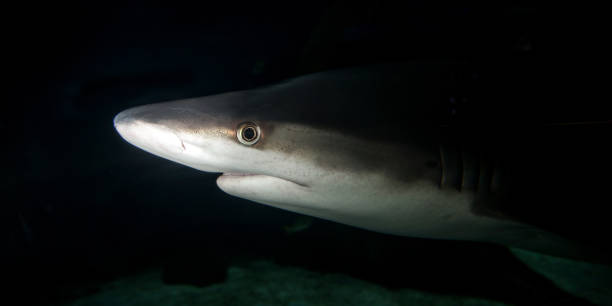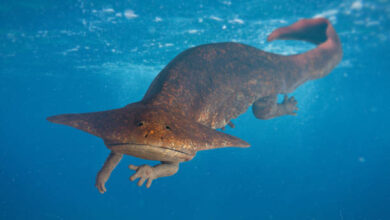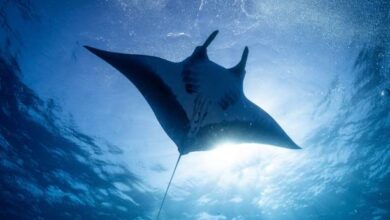Ten illustrations of cartilaginous fish and a diagram of cartilaginous fish

Within the vastness of our marine environment, cartilaginous fish are certainly visually appealing. These aquatic animals have long captivated scientists and fans of marine life alike with their distinctive anatomy and fascinating traits. We will go further into the aquatic realm of cartilaginous fish in this essay, examining their distinguishing traits, anatomical schematics, and some amazing instances.
Cartilaginous Fish: What Are They?
Introducing you to the amazing world of cartilaginous fish, also known as chondrichthyes, a class of aquatic organisms with cartilage-based skeletons instead of bone. Some of the most recognizable marine animals are included in this category, such as skates, rays, and sharks. Due to the cartilaginous nature of their skeletons, these marine organisms have an advantage over their bony cousins, Osteichthyes, in that they can move and are more flexible. Every characteristic possessed by cartilaginous fish has a function and helps ensure their survival in the various and frequently harsh oceanic habitats they call home. Get ready to explore further and discover more about these fascinating marine creatures.
Recognizing Cartilaginous Fish Features
Going into more detail, cartilaginous fish, also known as chondrichthyes, have a few distinct characteristics that make them stand out in the water. Above all, its fully cartilaginous skeleton presents an interesting combination of flexibility and lightness, in contrast to the hardness of bony fish. However, their anatomy is more complex than first glances. Unlike bony fish, which have a single gill cover, they have a characteristic array of five to seven gill slits on each side of their body. To further complicate matters, the majority of these fascinating animals have a covering of placoid scales, or “dermal denticles,” which give their skin a rough texture. Every trait reveals something new about the complex and interesting world of cartilaginous fish.
The Detailed Cartilaginous Fish Schematic
Observing the intricate details of a cartilaginous fish diagram reveals the wonders of the natural world’s creation. Designed for a life beneath the waves, the design is a remarkable fusion of economy and elegance. A streamlined body guarantees smooth movements, allowing one to pursue prey or avoid predators with equal ease. Properly positioned fins provide control and stability throughout the ebb and flow of the water. Their cartilaginous skeleton, which is incredibly flexible and provides an unmatched range of motion, is the foundation of their agility. However, it goes beyond only movement. A remarkable respiratory system with numerous gill slits designed for effective oxygen extraction is also depicted in the diagram. These animals are covered in placoid scales, or dermal denticles, which decrease water resistance and allow for stealthy, quick swimming. Each element in the design reveals a fascinating mystery about these underwater wonders as we dig deeper into the intricacies.
Ten Illustrations of Cartilaginous Fish
Prepare yourself for a voyage that will present you to ten fascinating kinds of cartilaginous fish. First on the list is the formidable Great White Shark, the pinnacle of marine predator strength. Not far behind in terms of originality, the flattened bodies and whip-like tails of the stingray mesmerize. Both the graceful glide of the Manta Ray, sometimes referred to as the “ocean’s eagle,” and the unusually shaped head of the Hammerhead Shark are captivating. Skate rays are fascinating because of their “mermaid’s purse”-like eggs. Take note of the Spotted Eagle Ray’s exquisite design and the adaptable Tiger Shark. Big yet friendly Whale Sharks filter-feed on plankton, while cute little Zebra Sharks entice visitors to aquariums. Last but not least, the Goblin Shark, a cartilaginous shark that lives in deep waters and has a projecting jaw, exemplifies the amazing adaptations seen in this species.
The Great White Shark
Introducing the formidable Great White Shark, a marine behemoth with unparalleled strength and agility that dominates the seas. Known for their enormous size, these vicious predators can grow to be over 20 feet long. They are able to easily traverse the wide ocean stretches thanks to their streamlined bodies, which are expertly designed for speed and agility. But their powerful jaws are what really stand out about them. Equipped with a set of sharp fangs, they quickly consume their victim. Nothing can elude a Great White, whether they’re chasing seals, lesser sharks, or even scavenging on whale carcasses. Come along as we explore the world of this apex predator in greater detail and take in the majestic beauty of the Great White Shark.
The Coral Reef
Explore the world of stingrays, an intriguing cartilaginous fish species distinguished by their long, whip-like tails and flattened bodies. Don’t be deceived by the calm appearance of these creatures as they glide through the water with ease. A powerful protection system against any predators that might dare to threaten them, the poisonous stinger found at the base of many stingray species’ tails is a formidable weapon. Their unusual form and special quality make them a very fascinating resident of the ocean’s depths. So join us as we discover the mysteries that lay beneath the beautiful exterior of the stingray and become engrossed in this fascinating world.
The shark’s hammerhead
Welcome to the fascinating world of the Hammerhead Shark, a fascinating cartilaginous fish distinguished by its distinctive head form. This amazing T-shaped structure is vital to the shark’s survival and isn’t merely for show. Few other marine organisms can match the wide-set eyes on either end of the ‘hammer’ for an extensive visual range. Their unique ability to see a wide area offers them a clear edge when hunting, enabling them to quickly identify possible targets. They can also move more easily due to their unusual head shape, which makes them great predators in the water. Explore the wonders of the Hammerhead Shark with us; it is a living example of how adaptable and resilient nature is in the always changing aquatic environment.

The Manta Ray
Come along with us as we glide through the Manta Ray’s watery environment. This amazing animal, dubbed the “eagle of the sea,” is praised for its captivating swimming abilities. The Manta Ray is an amazing sight in the open ocean, with its massive, wing-like pectoral fins and a body that may reach a remarkable 20 feet in length. Like the magnificent bird to which it is compared, the Manta Ray glides across the ocean with an absolutely breathtaking beauty and peace. its elegance isn’t its only remarkable trait, though. They have the most cerebral-to-body ratio of any cold-blooded fish, and they show a level of curiosity and intelligence uncommon in marine life. So fasten your seatbelts and join us as we continue to explore the wonders and intelligence of the magnificent manta ray.
The Roller
Take a voyage through the aquatic domain of the Skate, a near relative of the rays with comparable physical characteristics. Their broad, wing-like pectoral fins and flattened body are similar to those of rays, but they have an impressive way of reproducing. Not just any eggs, but eggs laid by skates. Encased in a robust, rectangular shell, these eggs go by the endearing nickname of “mermaid’s purse.” The developing embryos are protected from prospective predators by this amazing survival tactic. Inside every mermaid’s handbag is a skate that is just waiting to be developed and glide around the underwater world. Join us as we explore the underwater wonders of the Skate and learn the secrets of their egg-laying habits.
The Shark, the Tiger
Enter the fascinating realm of the Tiger Shark, a marine beast that gets its name from the black, vertical stripes that cover it. This species’ amazing capacity to adapt to different diets is what makes it so fascinating. The tiger shark is a carnivorous animal that will eat a wide variety of marine life, including seals, birds, and even smaller fish. These cartilaginous animals frequently swallow inedible things as well, which has earned them the moniker “garbage cans of the sea.” But don’t let their casual eating style mislead you; their adaptability and resilience allow them to survive in a variety of environments. The Tiger Shark maintains its position as the leading predator in the vast undersea realm because to its sharp, serrated teeth and excellent sense of smell. Come along as we continue to examine the amazing life of this versatile marine predator.
Ray, the Spotted Eagle
Now let’s explore the world of the Spotted Eagle Ray, a gorgeous cartilaginous fish species that definitely stands out from the crowd. Its unique triangular body, covered in a variety of dots, makes for an amazing sight as it scuttles through tropical waters. Its pointed, extended snout and pointed teeth are not only an attractive trait; they are essential for food searching in the sandy bottom. Watch as this aquatic beauty dives into the sand, mixing it up in quest of its next meal. It’s quite the sight. However, the Spotted Eagle Ray is unique in many ways than only its outward attributes. This species also exhibits an amazing migratory pattern, covering enormous maritime distances in massive schools. Come along with us as we delve further into the fascinating realm of the Spotted Eagle Ray and learn more about this spotted beauty.
The Whale Shark Come along on an exciting exploration of the world of the whale shark with us. The largest fish to ever swim our oceans, this enormous creature has a heart as soft as its size is powerful. Despite its intimidating size, this marine monster can swim calmly and lazily through the deep seas. The Whale Shark draws its food straight from the ocean by using its enormous mouth as a filter. Its primary food source is plankton. This gentle behemoth is not a predator, unlike many of its shark relatives. Its predilection for plankton over prey provides an unusual window into the diverse range of foods cartilaginous fish eat. The Whale Shark perfectly captures the majesty of the aquatic environment with an elegance that belies its size and a calmness that matches the depths of the water it lives in. Come along with us as we continue to uncover the fascinating lives of this peaceful, giant that enjoys plankton.
The Shark Zebra
Explore the wonderful world of the zebra shark, a species that is endearing in every hue. The juvenile Zebra Shark, which is recognized for its unique pattern, is a magnificent sight to behold. These bands develop into an entrancing tapestry of color as they become older, consisting of dark patches against lighter bodies. These organisms live along the ocean floor, using their small, flexible bodies to navigate the sand and coral. It is a popular attraction for visitors to public aquariums because of its friendly nature. This peaceful cartilaginous fish avoids fighting, satisfied to stroll gracefully and undulatingly down the ocean floor. The fascinating zebra shark’s existence is evidence of the wonders found beneath the surface of the ocean. Come along with us as we uncover additional details about this amazing animal and present a clear picture of life beneath the sea’s surface.
The Goblin Shark
Welcome to the mysterious Goblin Shark’s home—the dark, deep waters of the ocean. This unusual deep-sea resident is distinguished by its large, projecting jaw and its varicolored skin that ranges from pink to drab gray. This shark’s jaw serves a functional purpose in addition to being an eye-catching feature. It may jut forward in an instant, catching unwary prey with merciless efficiency. It’s an amazing illustration of the diversity and flexibility present in the world of cartilaginous fish. This spectral occupant of the underwater chasm offers a compelling contrast to its more well-known relatives. Explore the fascinating world of the goblin shark as we learn more about its amazing adaptations, which make it a true marvel of the marine world.



